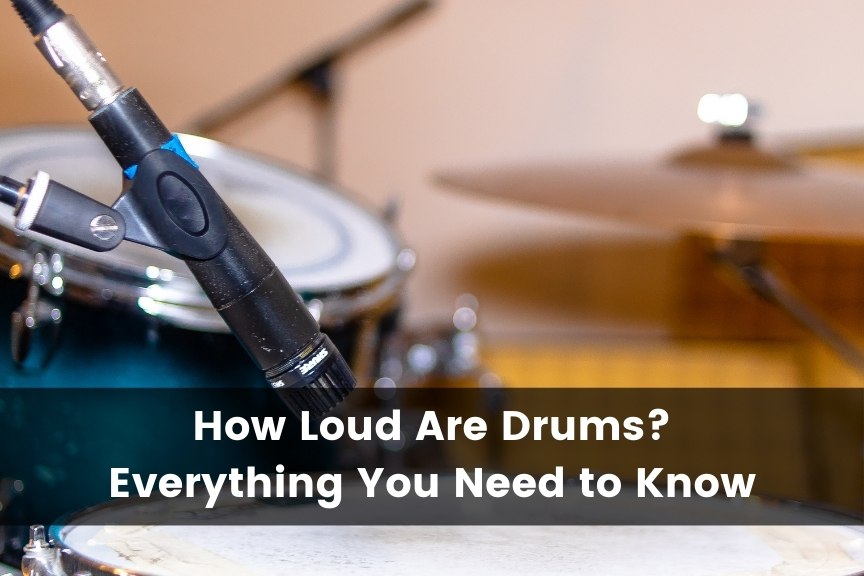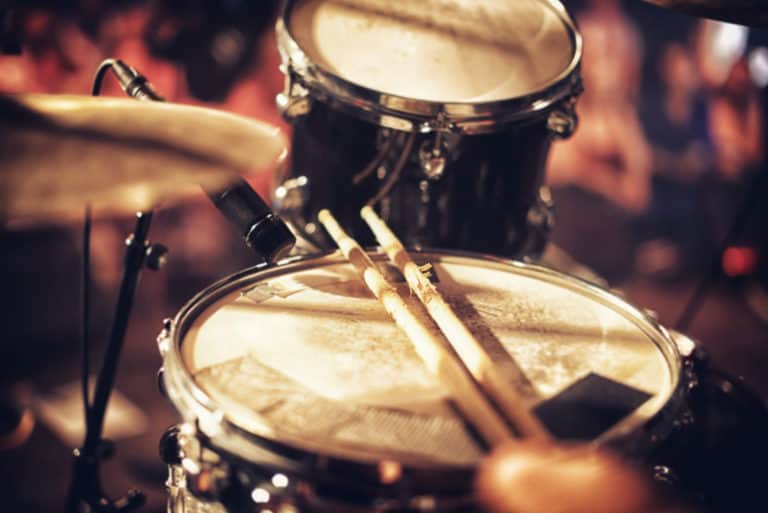How Loud Are Drums? Everything You Need to Know
The drum is one of the most culturally rich musical instruments. Though there are many different types of drums, they all have one thing in common: they are loud. The loudness of a drum kit can be measured in decibels (dB).
Drums can be as loud as between 90 and 130 decibels. Different drums vary quite a bit in how loud they are. Smaller drums would be closer to 90dB, but larger ones, like the tom-toms, can be as loud as 120 decibels. The drum’s diameter and depth are the two most significant factors in its loudness.
This article will look at how drums create their unique booming sounds and how these sounds are measured. We will also look at how you can best control your drum kit’s loudness.
How Drums Create Their Unique Sound
Drums are vital to every band’s sound, especially in genres like rock and reggae. Their percussive nature gives them a unique sound that complements the other instrumentation, making them irreplaceable. But how do they create their unique sound?
Drums have two primary components that work together to create sound. These parts are the shell, which contains the entire drum, and the drumhead.
The shell is made of wood or plastic and is hollowed out so that the musician can hit it with their hand or a stick to create sound.
The skin or head is the main component of a drum that produces sound when struck. As the drum head is struck, it compresses the air inside the shell. The compressed air is reflected off the bottom head and moves through the drum shell to create vibrations and the sound we hear.
However, these sounds will often vary depending on the size of the drum. The bigger the drum, the deeper the sound and visa-versa.
Diameter and Depth Are Important Sound Components
Drums may be made of different materials, but they all have one thing in common: they’re cylindrical. This shape gives drums their unique sound, regardless of the material they’re made from.
A drum’s cylindrical body’s vibrations enable these vibrations to travel through the instrument differently than those of a flat surface like a cymbal would. A drum’s tone depends on its shape as well as its size.
A drum’s diameter and depth can significantly affect the sound, which is why so much attention is given to both of these factors.
Of course, the material of the drum is also important – what it’s made of will make up most of the sound. However, suppose you’ve ever sat behind a drum set with instruments made from the same material but different diameters and depths. In that case, you’ll quickly notice that the tuning is different for each one.
Drums with larger diameters will always be louder than smaller ones because they have more surface area in contact with open air. For example, a balloon will always be louder when you blow it up because there’s more space for the air to move around and reflect off, creating more sound.
The depth of a drum has a similar effect on volume: if two drums are made from the same material, but one is more profound than the other, it stands to reason that it will always be louder because there’s more space for air to move around in.
Ultimately, the greater the diameter and depth of a drum, the thicker and deeper its tone will be. The smaller its diameter and depth is, you can expect its tone to be lighter and brighter. An excellent example is comparing your rack toms to your floor toms.
Tuning Can Affect Sound Too
When you’re learning to play the drums, you might feel like you need to make some noise immediately. Therefore, learning to tune your drums first might seem a little counterintuitive. However, there’s a reason why drum kits come with tuning keys – even if they aren’t always used. So, what’s the deal?
I’ll start by explaining that tuning your drums is to ensure that each drum head is set up to make the most distinct sound possible.
This is done by adjusting how tightly each drum head is stretched across its respective drum shell. If there is too much tension, the sound will get brighter, muffled, or deadened. If it is too loose, it can get darker or softer sounding. How the drum head is tuned depends on the resonant frequency a drummer prefers.
The ideal tension for any drum head depends on how it will be used. The snare head should ring out and emphasize a crisp crack over a thud. Meanwhile, tom-toms or bass drums create unique sounds depending on their size and tuning.
In either case, when a drum is tuned correctly, it will sound full and rich while still allowing its own unique character to shine through.
A Drum’s Loudness Is Measured in Decibels
Drums are a challenging instrument to get right. They’re not as simple as the guitar or a piano; the pounding rhythm and big sound can be overwhelming if you aren’t careful.
Even if you do everything correctly, it’s hard to tell how they’re coming across to others. Are they too loud? Too soft? How do they compare to the other instruments in your band? The best way to figure all this out is with some testing.
Using a decibel meter is a productive way to know how loud your drum is. A decibel meter is a device that enables you to measure sound intensity (or volume). It’s used to determine how loud a sound is, and is usually expressed as a decibels (dB) measurement. Decibel meters are beneficial in various situations, especially when you want to be aware of how loud your drums are.
Lonvox’s digital decibel meter is available on Amazon and can measure sounds ranging from 30 to 130 dB, making it perfect for testing your drums’ loudness.
Drums Are One of the Loudest Instruments Created
If you’re playing with a drummer, you cannot help but feel the power of a beat pounding through your body. The sound of drums can be felt in your heart, not just in your ear, and that’s why they have been used as an instrument in many cultures worldwide.
As previously stated, this instrument creates sound between 90 to 130 dB. Focusing on the traditional acoustic drum kit, each drum creates a different decibel level, so let us look at how these levels vary:
- Bass drum: Surprisingly, even though the bass drum is the largest in a kit, it does not produce the loudest sound. Their sound is read at a level of around 105 dB.
- Tom-tom drums: There are three toms in a drum kit: two rack toms and a floor tom. They produce deep sounds that measure around 110 dB.
- Snare drum: This drum produces a loud cracking sound. Drummers often utilize the sound of the drum’s head and rim. These sounds range between 90 and 120 dB – the equivalent of a subway train!
- Cymbals: This traditional acoustic drum kit component is typically the loudest. There are three cymbals in a kit: the hi-hat, the crash, and the ride cymbals. Their sound is emitted between 110 and 125 dB levels, with the crash cymbal being the loudest.
Of course, the loudness emitted from a drum will vary depending on how hard it is struck. But I’m sure you’re wondering at which point consuming loud sound (a high level of decibels) becomes a danger to your ears.
Drums Can Affect Your Hearing
Drums have a fantastic ability to put people in a good mood instantly. They’re a fun way to get people dancing, and the beat is infectious – it’s easy to understand why drum circles and kits have been so popular for so long.
However, there is a downside to all of this drumming. It can actually damage your hearing, and it’s not something that you’ll notice right away.
When you’re playing drums, you’re putting your ears through a lot of volume changes in a short amount of time. Think about how often you go from silence during the rests to the near-deafening sound when you strike the drum.
It doesn’t take much for these spikes in volume to start taking a toll on your hearing. Studies have shown that drummers are more susceptible to Noise Induced Hearing Loss (NIHL) than any other musician in the pop, rock, and jazz genres. The leading cause of NIHL is long-term exposure to the drums, which ultimately affects a drummer’s hearing.
If you’re a drummer and think you’re experiencing the effects of NIHL, here are some of the symptoms:
- Tinnitus or a ringing sound in the ears
- Hypersensitivity to sound
- Muffled speech
- A feeling of pressure in your ear.
The Centers for Disease Control and Prevention (CDC) put forward that if you’re experiencing noise over 70dB for an extended period, you’re more likely to damage your ears. This puts drummers at risk of NIHL and it should be taken into account when wanting to learn how to play the drums.
Nonetheless, you’ll be glad to hear various tips to quieten your kit are available to avoid noise-induced hearing loss risks.
Tips To Make Your Drums Quieter
Drums are often the loudest thing in a band’s practice space, which can be problematic if these sessions occur in an apartment or house with thin walls. When you’re trying to keep your drumming practice sessions under wraps, it’s easy to get overwhelmed by the amount of preparation and gear adjustment that may be required.
If your neighbors are bothered by the sound, with a few simple tips, you can make the process smooth and quiet without sacrificing the quality of your playing.
Use Mesh Heads To Reduce Your Drum’s Volume
Mesh drum heads are an easy way to reduce the volume of your drum without sacrificing sound quality.
Mesh heads like the Evans SoundOff from Amazon give you a great sound in various situations, which can be utilized almost anywhere. They don’t have the volume or tone of regular drumheads, however.
The most significant advantage of using mesh heads is that they are incredibly versatile and drastically reduce noise. You can tune them higher or lower for use in any situation, whether you’re playing jazz, rock, or heavy metal.
Consider Purchasing Electronic Drums
Electric drums are becoming an increasingly popular instrument. It’s no surprise, as they have many benefits over their acoustic counterparts. Besides them being cost-effective and portable, electric drums are highly versatile.
An electric drum kit usually includes a mix of pads and triggers that produce different sounds when hit. These sounds are sent through an amplifier through the kit’s computer or ‘brain.’ By adjusting the master volume of the amplifier, as well as the volume knob on the brain, you can control how loud your drums sound.
Electric drum sets reduce the chance of causing hearing loss because you don’t have to be playing through amplifiers with high volume levels that can damage your ears.
Additionally, on some kits, you can plug in a set of headphones which will allow you to control the loudness of your drums, too.
Place Drum Mutes on Top of Your Drum Heads
Drum mutes are a drummer’s best friend. Regardless of your skill level, every drummer, at some point in their career, will have to deal with a noisy neighbor or just not be able to practice late at night.
Drum mutes’ rubber pads are designed to be placed on the top of the drum head, reducing the drum volume significantly. They’re not perfect, but they can accommodate most situations and allow you to play at any hour without issue.
Drum mute pads don’t make the actual drum quieter, but they do change the way it sounds. The soft rubber on these pads is specifically designed to absorb noise when placed between two objects that are making noise.
To put it another way, drum mutes are designed to reduce the amount of vibration from one object to another by absorbing that vibration and turning it into heat energy.
If you think this is the route you’re going to take to reduce the loudness of your drums, then look at XCEL’s 6-Piece Rubber Drum Mute Pads (available on Amazon.com). These pads provide optimum noise reduction by using excellent quality material. By purchasing these, you’ll also be able to get cymbal pads, giving you the ultimate limiting of sound throughout your entire drum kit.
Low Volume Cymbals Reduce Volume by 80%
Considering that cymbals produce the highest dB leveling of the entire drum kit, you should seriously consider getting low-volume cymbals to reduce the risk of Noise Induced Hearing Loss.
If you’re looking for an excellent low-volume cymbal, look no further than Zildjian’s L80 Low Volume Cymbal Pack (available on Amazon.com), which comes with the ride, hi-hat, and crash cymbals that are 80% quieter than regular cymbals. Not only does this reduce the risk of NIHL, but it also helps drummers avoid ear fatigue when playing for an extended period.
Low-volume cymbals are an excellent option for those who want to reduce the volume of their cymbals but still have the versatility and tone that a good cymbal can provide. They’re great for playing in apartments and any other space where sound needs to be kept at a minimum.
Home Remedies
While buying all the extras can help you reduce your sound significantly, you don’t have to spend a lot of money to reduce how loud your drum is.
Drum dampening is something that can be done with a few household items, and here are some ideas to consider:
- Put a blanket inside your bass drum. Doing this will make a significant difference in the volume of the drum because the sound is reduced by muffling the sound vibrations produced by the drum head hitting the drum shell. It’s an excellent solution to the problem of wanting to play loudly while still being considerate of your neighbors.
- Place fabric on top of your drums. When you place something like a cloth or a towel over your drums, you reduce how much of the drum’s sound actually gets produced. The thicker the fabric, the more volume diminishes.
- Remove the bottom drum head. Taking off the bottom head would eliminate many vibrations that produce sound when the top head is struck. Usually, these vibrations would reflect off the bottom head to create sound. When they’re off, the only thing left would be the sound from the drum’s top head.
Drums are fantastic, but many people don’t like their constant booming sound. However, these simple home remedies will help make your drums quieter and benefit you (and your neighbors) greatly.
Summary
While the sounds of other instruments sometimes blend into a melodious cacophony that is music, or even in a busy but orderly symphony, there’s something about the sound of drums that stands out from the mix.
Whether the rhythm is fast and hard or slow and mellow, a drum introduces a feeling of excitement and anticipation. However, over a long period, there are some risks to being over-exposed to the high decibels drums create.
To avoid the risk of Noise Induced Hearing Loss (NIHL), you should practice preventative measures to reduce the overall volume of your drums.







